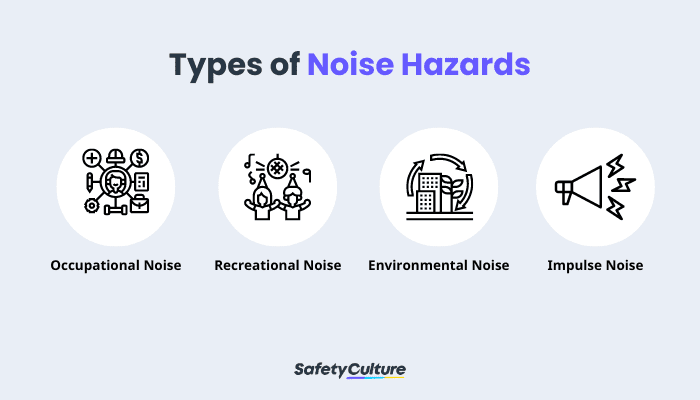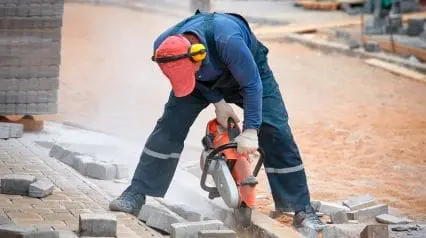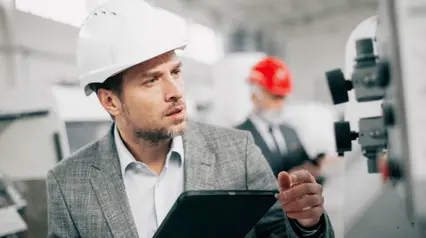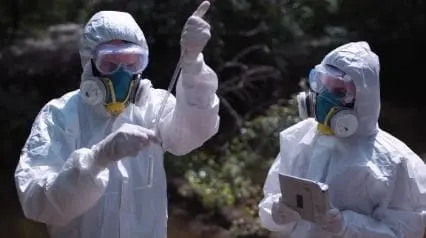What is a Noise Hazard?
A noise hazard refers to the exposure to excessive and prolonged levels of noise that has the potential to harm human health. It can be present in various settings, including workplaces, recreational activities, and residential areas. Typically, noise hazards are measured in decibels (dB), a unit of measurement for sound intensity.
The Occupational Safety and Health Administration (OSHA) has set legal limits on occupational noise exposure in the workplace to protect workers from its harmful effects. Hence, noise hazards can be considered workplace hazards as workers in high- and low-risk industries alike get exposed to noise.
What are the Types of Noise Hazards?

Various Types of Noise Hazards
While there are various ways to categorize noise hazards depending on the situation, level of exposure, and severity of their effects, the following are the most common noise hazard examples and types to note:
Occupational noise
This type of noise is generated in the workplace that can cause hearing damage and other negative health effects to workers. Typically, it’s produced by machinery, equipment, tools, or processes involved in industrial or manufacturing operations.
In addition to the direct health effects, occupational noise can lead to decreased productivity, communication difficulties, and other safety hazards. Hence, noise safety programs and control measures are encouraged and are considered the responsibility of employers to protect workers’ health and safety.
Recreational noise
This type of noise refers to the sound generated by leisure activities created and participated in by people for enjoyment and socialization opportunities. Such activities include the following:
- Music concerts
- Sporting events
- Cultural festivals
- Video arcades
- Movie theaters
Recreational noise can lead to hearing loss, sleep disturbance, stress, annoyance, and other health problems. Also, it can have negative impacts on wildlife and disturb the natural soundscapes of ecosystems if proper measures aren’t implemented.
Environmental noise
This refers to any unwanted noise or excessive sound levels created by human activities or natural sources in the environment. While this can negatively affect human health, it can also disrupt the environment, including animal behavior and feeding patterns.
A few common examples of where environmental noise comes from are the following:
- Transportation – road traffic, trains, etc.
- Industrial activities – operating machinery, construction, etc.
- Neighborhood – motorized gardening equipment, noisy house appliances, etc.
To mitigate such, measures such as noise barriers, zoning, and noise-reducing technologies can be used.
Impulse noise
This refers to the unwanted noise carrying a sudden sharp sound often caused by a brief, sudden increase in decibels. Some examples include a sledgehammer blow, explosion, or gunfire.
Also, this type of noise is most prevalent in the construction and demolition industries. Workers in these sectors use heavy-duty equipment and perform disruptive processes that create impulse noises.
Health Effects of Excessive Noise Hazard Exposure
It’s important to note that the severity of health effects depends on the intensity and duration of the noise hazard exposure. Some of these notable implications include the following:
- Temporary and permanent hearing loss – While temporary hearing loss is usually reversible as the individual’s hearing returns to normal after a few hours or days, repeated exposure to a loud noise hazard can lead to permanent hearing loss.
- Tinnitus – This is when an individual experiences a ringing, buzzing, or humming sound in one or both ears. The intensity varies and it can be temporary or permanent, and can affect a person’s quality of life, making it difficult to concentrate or sleep.
- Hyperacusis – This is a condition where one becomes extremely sensitive to noise. Even moderate noise levels can be painful and uncomfortable, which is usually caused by damage to the inner ear.
- Non-auditory health effects – Exposure to excessive noise can also lead to increased stress, high blood pressure, and cardiovascular diseases.
Standards and Regulations
To help employers establish effective noise safety measures and provide a safe workplace, the following standards and regulations for each country or region apply:
- United States (US) – The OSHA’s Occupational Noise Exposure states that if workers are to be exposed to 85 dB of noise or higher, employers should administer an effective hearing conservation program. Other standards include the following:
- Environmental Protection Agency (EPA)’s Noise Control Act of 1972
- The Centers for Disease Control (CDC)’s National Institute for Occupational Safety and Health (NIOSH)
- Australia – Similar to OSHA, Safe Work Australia’s noise exposure standard states that workers must not be exposed to above 85 dB on average, over the course of an 8-hour shift.
- United Kingdom (UK) – The UK’s Health and Safety Executive (HSE) recommends that employers must provide hearing protection to workers when they’re exposed to 85 dB and that risk assessments be conducted when the exposure level is at 80 dB.
- European Union (EU) – The EU’s OSHA sets exposure limit values fixed at 87 dB while exposure action values at 80 dB (lower value) and 85 dB (upper value).
- Further reading: Noise fact sheets
Best Practices for Managing Noise Hazard Exposure
Some steps that employers can take are the following:
- Proactively identify noise hazards and risks to create action plans in addressing them.
- Implement noise control measures to limit exposure:
- Engineering controls – noise barriers, mufflers, or silencers on machinery and equipment to reduce the noise
- Administrative controls – scheduling noisy activities during off-hours, rotating workers to limit exposure time, or providing quiet areas for breaks
- Personal Protective Equipment (PPE) – use of earplugs and earmuffs; proper fitting and maintenance of hearing protection
- Train and educate employees on the risks associated with noise exposure, how to use PPE correctly, and how to identify and report problems.
- Regularly monitor noise levels to ensure that controls are adequate and identify any changes in noise exposure that may require additional measures.
- Inspect and maintain machinery and equipment to ensure that noise-reducing measures are functioning properly.
Create Your Own Noise Hazard Identification Checklist
Eliminate manual tasks and streamline your operations.
Get started for FREE



